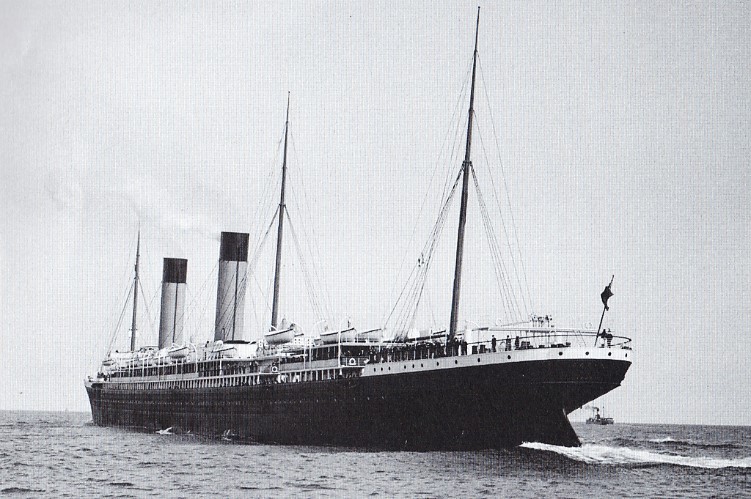New Developments at the WSL
The WSL was one of the most successful lines operating on the North Atlantic. Ismay believed that more new ships should be built but he did not want to spend any more of his own money. He looked to the government for financial assistance and suggested the Admiralty supervise building so that the ships could easily be converted into armed merchant cruisers in the event of war.
An agreement was reached which was known as The British Auxiliary Armed Cruiser Agreement. Building commenced on the Teutonic in March 1887, closely followed by the Majestic.
Royal Mail Ship (RMS)
The term Royal Mail Ship (RMS) dates back to 1840 and the pioneering days of the paddle steamers all of which had carried transatlantic mail. It is used for seagoing vessels that carry mail under contract for British Royal Mail.
Any vessel designated as RMS has the right to fly both the pennant of the Royal Mail when sailing and to include the Royal Mail crown insignia with any identifying device and/or design for the ship.
It is likely that all the earlier steamers of the WSL carried mail in a private capacity but in 1877, the WSL was financed by a mail contract after which all ships of the WSL incorporated RMS.
The Board of Trade Lifesaving Appliances Committee was established in 1888 and elected Thomas H. Ismay as chairman. The committee would lay down regulations regarding the number of lifeboats passenger vessel should have.
The Merchant Shipping Act 1894 included a table showing the minimum number of lifeboats to be placed under davits, and their minimum cubic contents. This table was still based on the gross tonnage of the vessels and not upon the number of people carried. It provided for increasing number of lifeboats as the vessel tonnage increased but it stopped short at the point where the gross tonnage of the vessels reached 10,000 tons and upwards.
The Titanic, with a gross tonnage of 46,000 carried 20 lifeboats, exceeding the regulations laid down by the Board of Trade, which required her to carry lifeboats capable of carrying a total of 1,060 people. The Titanic's lifeboats had a capacity of 1,178 people and yet her size was capable of carrying 3,330 people.
“The First White Star Line Liners”
RMS Teutonic (1889)
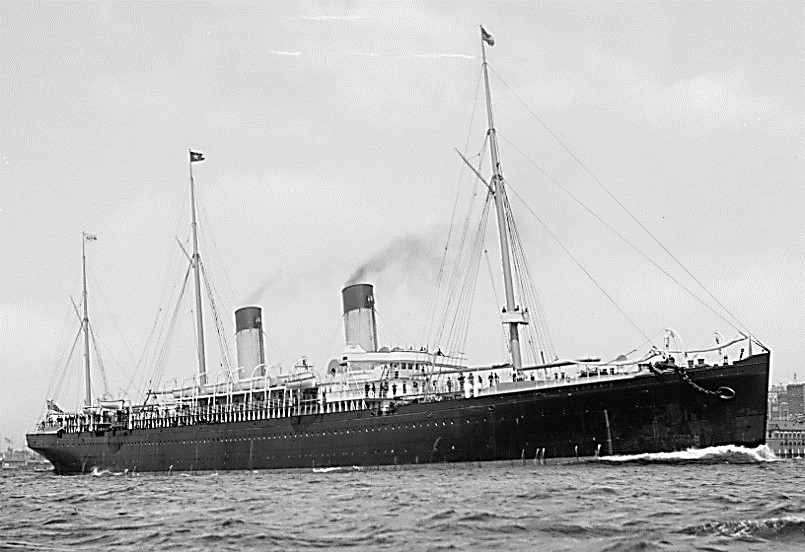
The Teutonic was built by Harland and Wolff under keel number 208, launched on 19 January 1889 and completed on 25 July 1889. She was 582 feet long with a beam of 57.8 feet and had a gross tonnage of 9,984. She was designed to serve the Royal Navy as an armed merchant cruiser in the event of war and during her fitting out, she was armed with 84.7 inch quick firing guns.
The Teutonic joined the British naval fleet at Spithead on 3 August 1889 for a naval review to mark the visit of Kaiser Wilhelm II, the German Emperor. The review was postponed until Monday 5 August due to bad weather.
On the previous day, the Teutonic was visited by the Prince of Wales (the future King Edward VII) with his nephew, Kaiser Wilhelm II, the German Emperor. Kaiser Wilhelm was very impressed with the ship and said: “We must have some of these.”
The inspection lasted 2½ hours and afterwards the Teutonic’s guns were removed.
The Teutonic’s maiden voyage from Liverpool to New York began on 7 August 1889. The crossing lasted six days, 14 hours and 20 minutes. She had replaced the Baltic.
On 19 August 1891, the Teutonic won the Blue Riband for the last time for the WSL after she sailed to Liverpool in five days, sixteen hours and thirty one minutes.
For nearly 20 years she serviced the Atlantic route. Along the way, there was a stop at Queenstown (now Cobh since 1920) to pick up more passengers.
1897 celebrated Queen Victoria’s Diamond Jubilee: 60th year as monarch. In her honour, another naval review of Her Majesty’s ships at Spithead took place.
The Teutonic was rearmed to give the appearance that she was an armed merchant ship. She continued to service the routes until replaced in 1911 by the Olympic. She was scrapped in 1921, following service as a merchant cruiser and a troopship in the First World War.
RMS Majestic (1889)
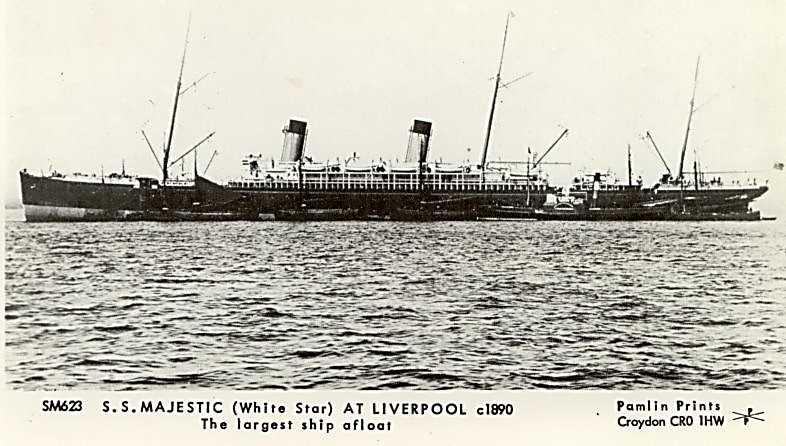
The Majestic was built by Harland and Wolff under yard number 209 and was launched on 29 June 1889. She was completed by March 1890 after a nine-month fitting out. She was 582 feet long with a beam of 57.8 feet and had a gross tonnage of 9,965. Her maiden voyage began on 2 April 1890 sailing from Liverpool to New York. Although she was fast with an average speed of 20.1 knots, she was not fast enough to take the Blue Riband away from the City of Paris.
Her captain, Edward John Smith, served on the Majestic for nine years. Charles Herbert Lightoller served as deck officer on the Majestic.
During the Boer War, the Majestic was used as a troopship transporting soldiers to the Cape Colony.
The Majestic was to retire in 1912 when the Titanic was launched. However, the loss of the Titanic on her maiden voyage meant she returned to service as a transatlantic liner. She was sold for £26,700 and scrapped on 14 January 1914.
The interiors of the Teutonic and the Majestic were similar. The Teutonic had rooms for 300 First Class passengers situated in very spacious cabins on her uppermost three decks. She could accommodate 190 Second Class (or “Cabin Class”) and 1000 Steerage (Third Class) passengers.
RMS Gothic

The Gothic was built in 1893 by Harland and Wolff under yard number 267. She was completed on 28 November and commenced her maiden voyage on 28 December 1893. She was 490 feet long with a beam of 53 feet and had a gross tonnage of 7755. She would service the London to New Zealand route under the command of Captain William H. Kidlay. At the time she was the largest ship afloat.
During her career, she swapped between the Red Star Line and the WSL. In 1924, she ran aground and following an examination, it was decided that the ship was no longer economically viable and was scrapped in 1925.
On Christmas Eve 1895, Sir Edward Harland died. Thomas Ismay attended the funeral. Ismay felt the loss of his friend and recognized the success of the WSL was largely due to the innovative vessels produced from the Harland and Wolff shipyard.
On 31 December 1897, the Oceanic Steam Navigation Company moved offices from 10 Water Street, Liverpool to new purpose-built offices at 30 James Street, Liverpool designed by the successful architect Norman Shaw.
The “Jubilee class” liners
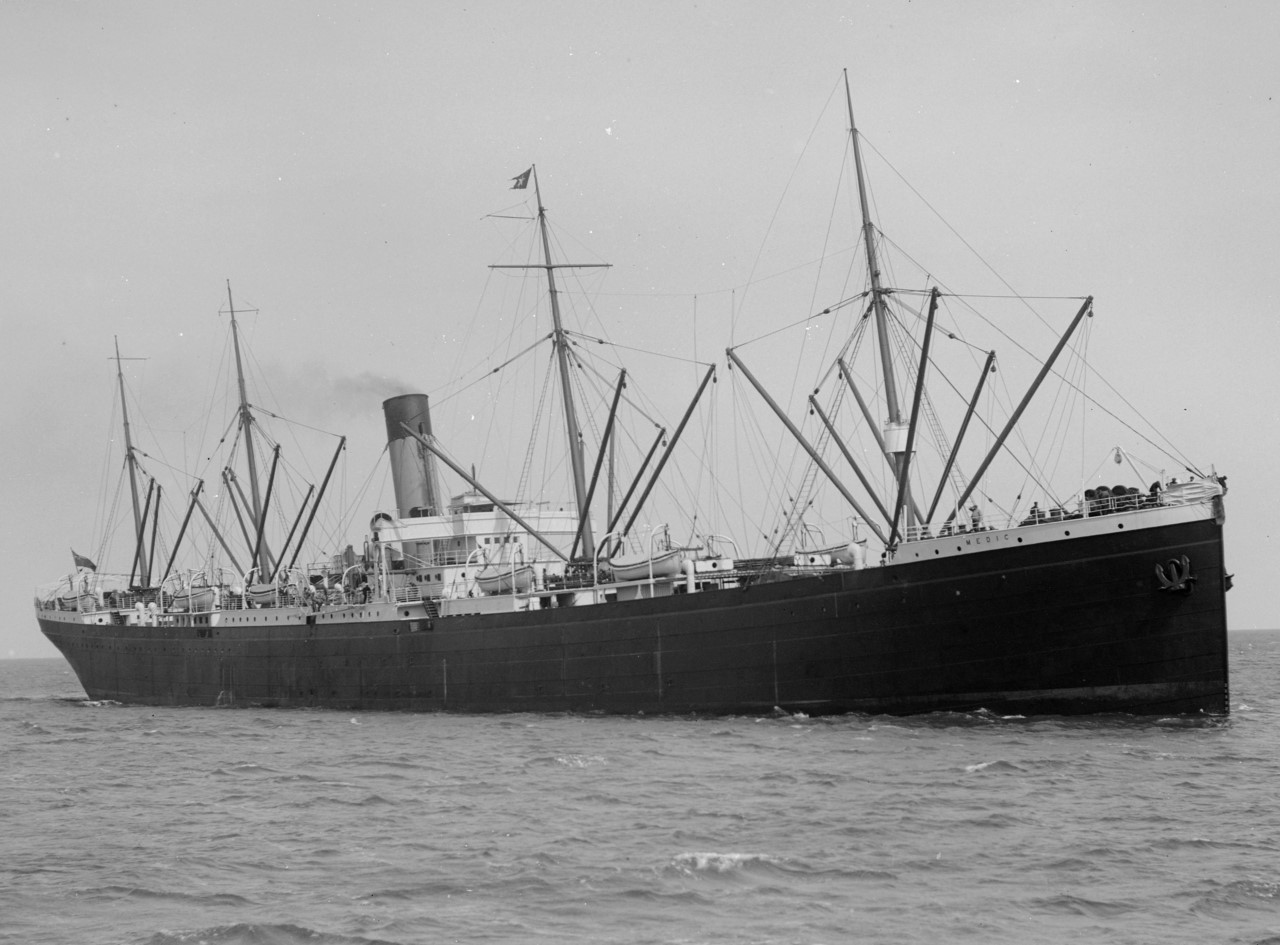
The Medic was one of five “Jubilee class” liners built by Harland and Wolff in 1899. Her sisters were Afric, Persic, Suevic, and Runic.
All sisters were to service the Liverpool – Cape Town – Sydney route. They were all single funnelled. The Medic could carry 320 steerage passengers. The sisters were 430 feet long and comparatively narrow with a beam of 45 feet.
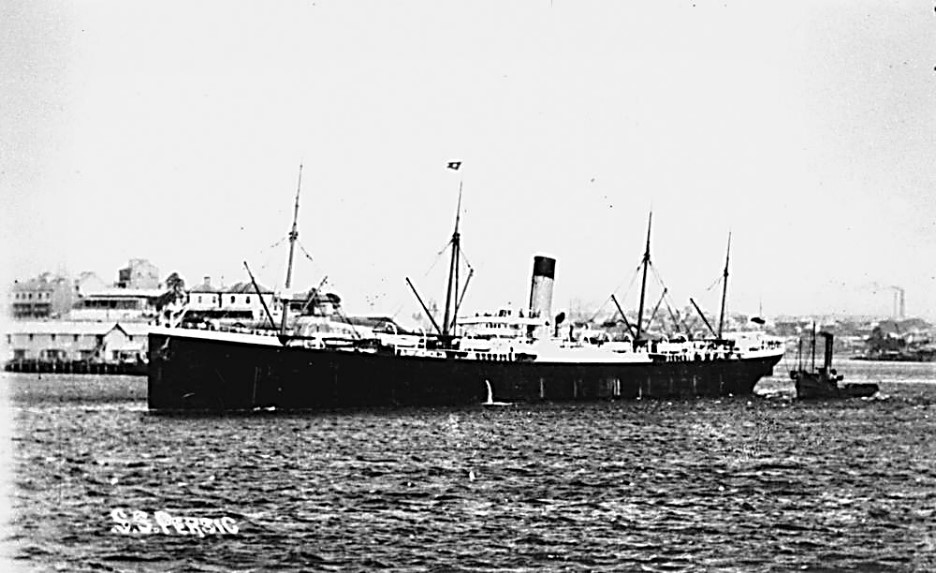
SS Runic (1889)
The Runic was built by Harland and Wolff under keel number 211, launched on 1 January 1889 and completed by 16 February 1889. She was 550.2 feet long with a beam of 63.3 feet and had a gross tonnage of 12,482. Her maiden voyage took place on 21 February 1889.
In May 1895, she was sold to West Indies and Pacific Steamship Line and renamed the Tampican. On 31 December 1899 she was sold to Frederick Leyland and Co and sold several times after that. The Southern Pacific Whaling Company bought her in 1912 to serve as a whaling supply ship and was renamed SS Imo.
In 1917, the Imo, was employed as a relief ship for the Belgian Relief Commission. The name of the commission was painted along the side of the ship, indicating that she was neutral in times of war. She sailed to New York to pick up supplies and arrived at Halifax, Nova Scotia on 3 December.
There were issues with her refuelling and her departure was delayed.
Because of her size, the Imo found it difficult to manoeuvre in the harbour. Her propeller and rudder protruded out of the water which made reversing difficult. When cleared to leave, the ship entered the Narrows travelling too fast. An American tramp steamer, Clara was travelling on the wrong side of the harbour.
Both ships signalled to each other and agreed to pass starboard to starboard. The Imo headed at excessive speed straight for the Mont-Blanc. The Mont-Blanc was carrying wartime munitions and explosives. To avoid a collision, the pilot ordered her to steer hard-a-port. The Imo reversed its engines which led to her swinging into the Mont-Blanc.
Unfortunately, the collision caused barrels containing the highly inflammable liquid benzyl to crack open. As the Imo reversed away from the Mont-Blanc sparks set light to the benzyl. An uncontrollable fire started necessitating the captain to order the ship to be abandoned. The ship exploded and debris was thrown all around the harbour.
The Imo was badly damaged, her captain was killed along with three other officers on the bridge. It was estimated that approximately 2000 people were killed and over 9000 injured by the blast.
The subsequent inquiry found the crew of the Imo were not responsible for the collision and the blame was attached to the Mont-Blanc. A later appeal found that both vessels were to blame equally for the disaster.
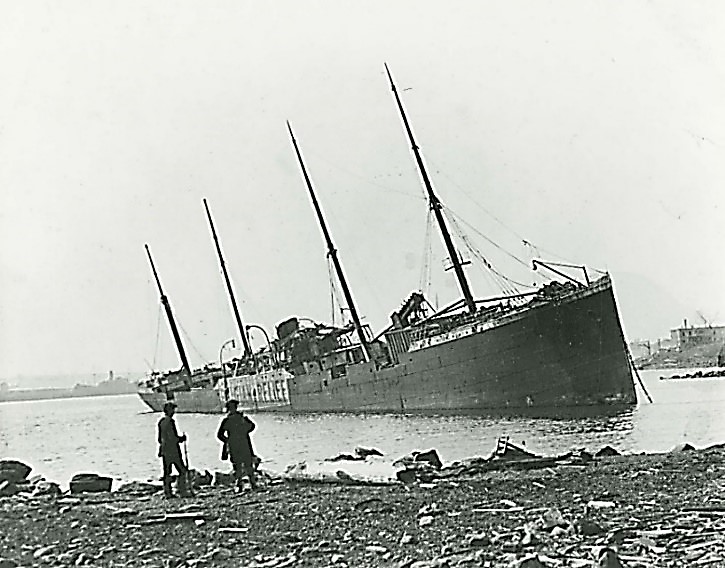
The Imo was repaired and returned to service. She ran aground on rocks at Cow Bay, East Falkland Islands on 30 November 1921. The ship was left to the peril of the sea.
SS Suevic
The Suevic was built by Harland and Wolff under keel number 333. She was 565 feet long with a beam of 63.3 feet and had a gross tonnage of 12,531. She could carry 400 Steerage passengers and maintain speed of 13.5 knots. She was a “Jubilee class” liners.
Her design was slightly different from the Runic. The poop deck was lengthened and the bridge was moved closer to her bow.
Her maiden voyage took place on 23 March 1901 from Liverpool to Sydney. Not long into her service she was commissioned by the Royal Navy as a troopship. After the Boer War ended, the WSL assigned her to the Australian route.
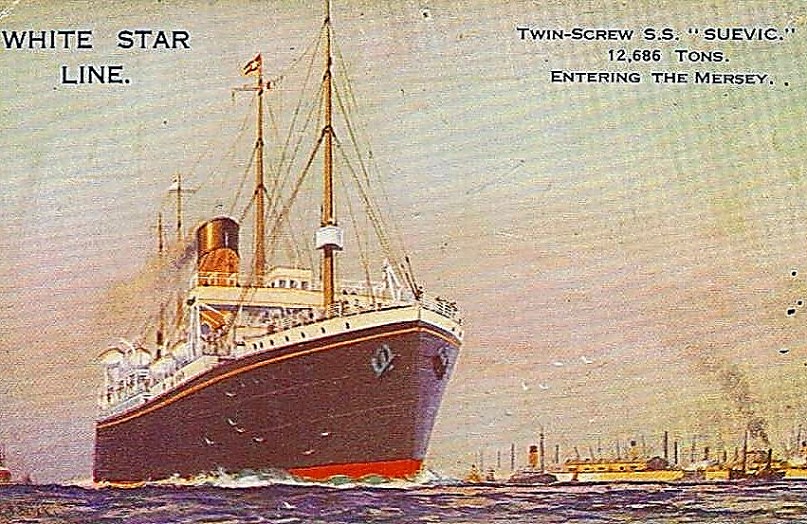
On 2 February 1907, the Suevic left Melbourne for Liverpool under the command of Thomas Jones. She carried 382 passengers and 141 crew and cargo comprising of sheep carcasses.
On 17 March, the ship sailed into thick fog. The surrounding area was particular dangerous due to shallow waters and sharp rocks. The navigators spotted the “Lizard” lighthouse on a peninsula off the Cornish coast of England. They thought it was 10 miles away and continued on their course at full speed.
The ship ran aground on Maenheere Reef. There had been a miscalculation of about 16 miles. Captain Jones ordered the engines “full astern” but as the ship would not slip off the rock he ordered distress rockets to be fired.
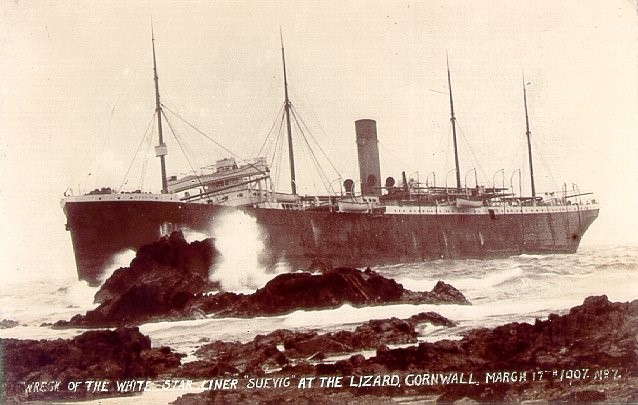
A 16 hour rescue operation began and all passengers and crew disembarked without the loss of life. The success of the rescue was mainly achievable because of the Royal National Lifeboat Institution (RNLI). The RNLI is a volunteer organisation founded in 1824. The volunteers came from local towns and it was the biggest operation that the RNLI had undertaken in its history. Several volunteers were awarded gallantry medals.
Once emptied of its cargo, the WSL began a salvage operation. The bow was badly damaged but the rest of the liner was still intact and undamaged.
Unfortunately, the weather deteriorated and the bow would not move despite several efforts to move it.
On 4 April 1907, in a final attempt to save the vessel, it was decided that the bow should be severed just aft of the bridge by using dynamite. The bow was separated on the watertight joints using controlled explosions and the aft half floated free. The stern did not sink because the watertight compartments held.
Her engines were not damaged and powered the ship back to Southampton.
History was made when the WSL ordered a new 212 feet bow section, something never tried before. By October, the new section was completed by Harland and Wolff. It was towed to the Thornycroft Shipyard at Chiswick, to be attached to the rest of the ship. The bow fit perfectly into place and was a testament to the skill and expertise of Harland and Wolff. On 14 January 1908, she returned to service.
During the First World War, Suevic, was refitted and the accommodation capacity was increased to carry an extra 266 Second Class passengers.
By 1928, the Suevic showed signs of fatigue, and was sold to Yngvar Hvistendahl’s Finnhual for £35,000. She was renamed Skytteren and converted to a whaling factory ship.
Following the outbreak of the Second World War, Skytteren was interned in Sweden. Along with nine others she tried to escape to Allied controlled waters, but they sailed directly towards German warships. The Skytteren and seven others were sunk.
RMS Oceanic (1899)
The Oceanic was built by Harland and Wolff under keel number 317. Her keel was laid in January 1897 and was launched on 14 January 1899. Her construction was supervised by Thomas Ismay. She was the first ship to exceed the size of Isambard Kingdom Brunel’s Great Eastern of 1858. She had a gross tonnage of 17,272 and was 704 feet long with a beam of 68.4 feet. Quickly she became to be known as the “Queen of the Seas.”
The Oceanic was the pride of the WSL. She would accommodate 1,700 passengers, with 349 crew. Her launch on 14 January 1899 was watched by Ismay and his wife. They stayed with the Pirries. William James Pirrie had taken over as head of the Harland and Wolff when Edward Harland retired in 1895. Not long after the launching, Ismay began to complain of pains in his chest and he needed bed rest to recover. From 13 September 1899 until 23 November, he suffered several heart attacks and died.
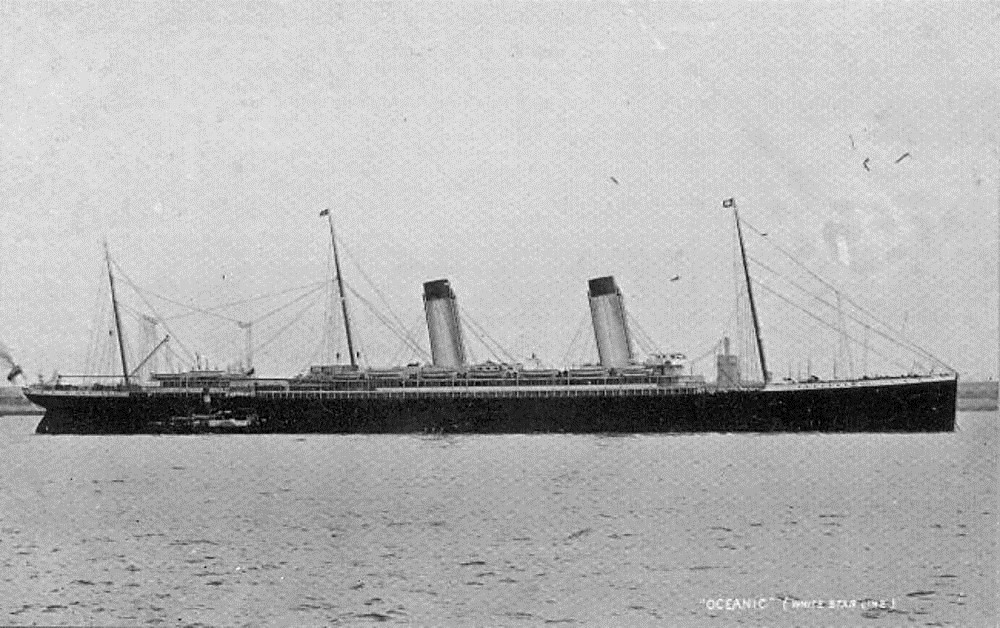
The Oceanic fell short of Ismay’s aspirations. In 1900, she nearly ran aground off the coast of Lancashire due to heavy fog. Fortunately, she was rescued by local skipper who put her on the right course. In 1901, she was involved in a collision with the Kincora which led to the deaths of seven men. In 1905, she suffered from a mutiny on board.
In 1912, she had a near miss collision with the Titanic. She tried to avoid a collision with the New York who had broken away from her moorings due to the Titanic’s great suction from her huge propellers.
Charles Lightoller in his 1935 book, “Titanic and other Ships”, wrote about his experiences on the ship.
“I got my severest mail boat training during the seven hard, though happy years I spent in the "Queen of the Seas", as the Oceanic was then called. A wonderful ship, built in a class of her own, and by herself. The usual custom is to build twin ships, as with the Britannic and Germanic, Teutonic and Majestic. Then, in lone and stately majesty came the Oceanic. She was an experiment, and a wonderfully successful one; built by Harland and Wolff, regardless of cost, elaborate to a degree, money lavished where it was necessary, but never gaudily as is so common nowadays. Her smoke room doors were a masterpiece in themselves, and cost £500. There was eighteen carat gold plating on the electric light fittings throughout the saloon and staircase, and paintings by well-known artists, worth a cool thousand apiece. Hand carvings of delicate work, and the joy of souvenir hunters. Every deck plank was picked wood. Last, but by no means least, her Captain, John G. Cameron. A martinet to his fingertips, who set a standard that I for one, found it difficult to live up to.”
On 8 August 1914, she was commissioned into naval service as an armed merchant cruiser primarily to guard waters near the Shetland Islands.
On 7 September 1914, an inaccurate fix of their position was made by navigator Lieutenant David Blair RNR. It caused them to run aground onto the Shaalds of Foula reef. The hull of the ship was ruptured. The Lyons, an Admiralty salvage vessel was dispatched quickly. Charles Lightoller was the last man off the ship. Lieutenant Blair was court martialled and found guilty of “stranding or suffering to be stranded” the HMS Oceanic. Commander Henry Smith was acquitted at his court martial.
The hull of the ship remained under the water until 1973 when work began to remove it. By 1979, the last remains had been salvaged.
